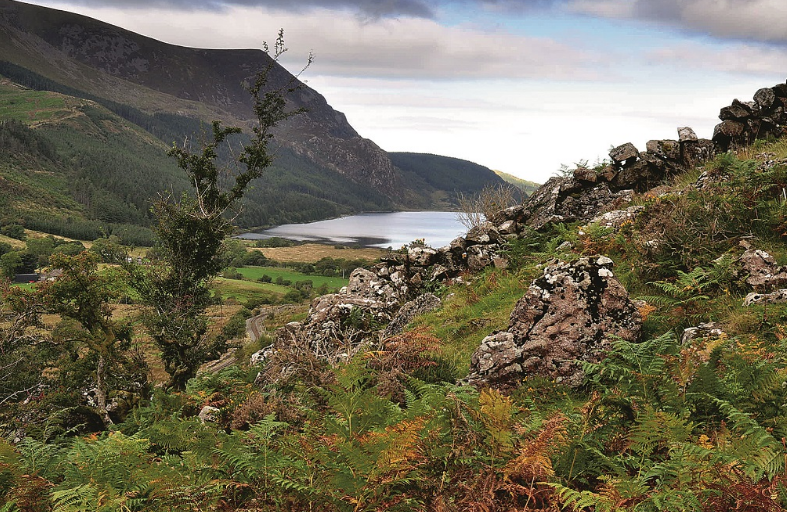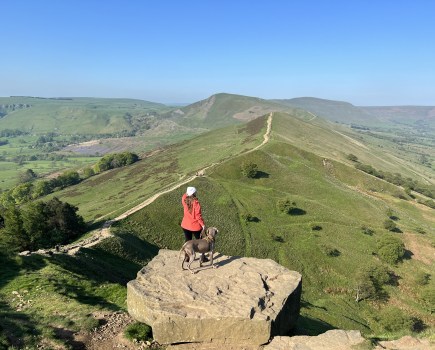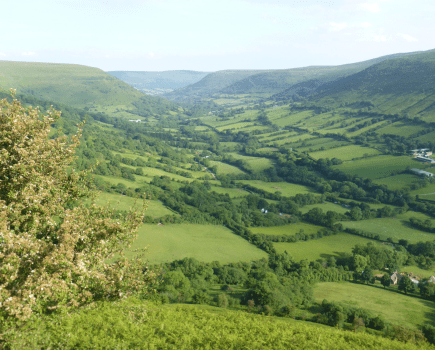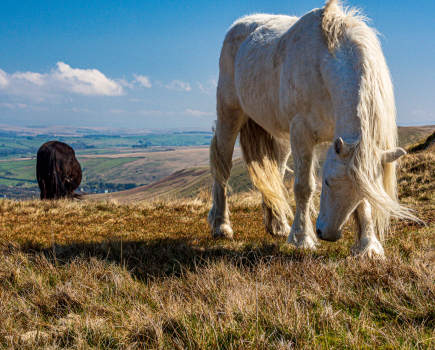Andrew Galloway investigates the folklore of the lesser visited side of Snowdon
On the western flanks of Yr Wyddfa (Snowdon), among the hamlets and villages of Nant y Betws and Dyffryn Nantlle there persists an oral folklore tradition of faerie folk who, it is believed, once lived among the secluded glens and cymoedd of this more remote province of Snowdonia. One particular story from Betws Garmon, which is recounted again and again in many localities with only subtle changes to the narrative, tells of a young farmer, who accidentally comes across the faerie folk in a meadow high upon the mountain, intoxicated in their night-time revelries. Fascinated by the spectacle he returns again and again to view the bacchanalian scene, eventually plucking up enough courage to abduct one of the females and take her back to his farm (this is well before the Human Rights and Equality Act we assume).
By means of much kindness he eventually persuades her to stay as his maidservant, but as she is very beautiful, he soon falls in love with her and proposes marriage. For some considerable time she is unwilling to countenance such a proposition, but eventually concedes upon one sole condition: that he never strike her with iron, for should he do so she would leave him and not return.
Her exceptional skill at tending to cattle ensured that he soon became a wealthy man and she eventually provided him with a son and a daughter. They lived happily for many years until one fateful day when the farmer was attempting to saddle a young filly that would not capitulate. In his frustration he threw the iron bridle into the air, whence it landed across the shoulder of his wife, who immediately disappeared, never to be seen again.
There are several motifs here that give an indication of what might lie behind such folklore tales, perhaps most significantly the destructive nature of iron. It is entirely likely that as Celtic settlers moved westwards from the Danube basin into Britain during what loosely can be referred to as the Bronze Age and Iron Age, they would have encountered an indigenous people thus forced into more remote parts of the countryside and living in fear of the new immigrants.
When Thomas Pennant visited Snowdon in 1773 he was guided to the summit by one Hugh Shone of Llanberis, taking the route to Bwlch y Cwm Brwynog and then by what is now known as the Ranger Path. Upon passing above Cwm Clogwyn, Shone recounted to Pennant that the small lakes of Llyn Glas, Llyn y Nadroedd and Llyn Coch were known to be the localities where in ancient times the little people would keep their revelries; perhaps where our Betws Garmon farmer first observed his to-be wife.
Stories of faeries may seem fanciful to us, particularly having been exposed to Disney’s Tinkerbell and the Victorian sentimentalism of faeries at the bottom of the garden. But these archaic stories offer us an echo of a folk memory of interaction between very different cultures, perhaps resulting in conflict but also in love and children, the descendants of whom, some believe, live still in the peaceful and secluded valleys of Eiffionydd.
ROUTE DESCRIPTION
- From Rhyd Ddu station head N but do not take the ‘Rhyd-Ddu Path’ to Snowdon. Instead take the track NW into the village, then NE through an iron kissing gate onto common land.
- Follow this footpath, marked by regular posts, across meadow and pasture until you cross the Welsh Highland Railway. Continue along the path behind Clogwyn-y-gwin until you reach the abandoned slate quarries.
- At the incline, leave the indicated path, turning instead E and find your way to the south of the deep oval-shaped quarry with a turquoise pool at the bottom – taking care as the sides are very steep!
- Take a bearing of 075 across access land for 1.6km to lead you to the shore of Llyn Nadroedd. This will necessitate crossing a considerable stonewall. There are no stiles, but there are a number of places where in situ boulders have been built into the wall, which facilitate crossing. Please remember to replace any stones you may dislodged (the only alternative is to head NW into Cwm Treweunydd then follow Afon Goch upstream to reach the Cwm).
- Take some time to explore the seldom visited natural amphitheatre of Cwm Clogwyn, returning to Llyn Coch and Llyn Glas.
- From Llyn Glas head NW for 1km to reach Llyn Ffynnon-y-gwas and traverse the west shore, looking back for dramatic views.
- Cross the Ranger Path above the sheep fold and follow the wire fence from Bwlch y Cwm Brwynog to Moel Cynghorion (at the ladder stile, turn around for, in good conditions, one of the best views of Snowdon).
- Follow the fence (bearing 244) along Bwlch Carreg y Gigfran for just over 1km then head S down slope to the intersection of paths, walls and streams at (GR: SH575554).
- Cross the Ranger Path once again, and take the ladder stile into the meadow to follow the post-marked path to return to the slate quarries.
- From the incline retrace your steps along the post-marked path to Rhyd Ddu station.
Andrew Galloway investigates the folklore of the lesser visited side of Snowdon
On the western flanks of Yr Wyddfa (Snowdon), among the hamlets and villages of Nant y Betws and Dyffryn Nantlle there persists an oral folklore tradition of faerie folk who, it is believed, once lived among the secluded glens and cymoedd of this more remote province of Snowdonia. One particular story from Betws Garmon, which is recounted again and again in many localities with only subtle changes to the narrative, tells of a young farmer, who accidentally comes across the faerie folk in a meadow high upon the mountain, intoxicated in their night-time revelries. Fascinated by the spectacle he returns again and again to view the bacchanalian scene, eventually plucking up enough courage to abduct one of the females and take her back to his farm (this is well before the Human Rights and Equality Act we assume).
By means of much kindness he eventually persuades her to stay as his maidservant, but as she is very beautiful, he soon falls in love with her and proposes marriage. For some considerable time she is unwilling to countenance such a proposition, but eventually concedes upon one sole condition: that he never strike her with iron, for should he do so she would leave him and not return.
Her exceptional skill at tending to cattle ensured that he soon became a wealthy man and she eventually provided him with a son and a daughter. They lived happily for many years until one fateful day when the farmer was attempting to saddle a young filly that would not capitulate. In his frustration he threw the iron bridle into the air, whence it landed across the shoulder of his wife, who immediately disappeared, never to be seen again.
There are several motifs here that give an indication of what might lie behind such folklore tales, perhaps most significantly the destructive nature of iron. It is entirely likely that as Celtic settlers moved westwards from the Danube basin into Britain during what loosely can be referred to as the Bronze Age and Iron Age, they would have encountered an indigenous people thus forced into more remote parts of the countryside and living in fear of the new immigrants.
When Thomas Pennant visited Snowdon in 1773 he was guided to the summit by one Hugh Shone of Llanberis, taking the route to Bwlch y Cwm Brwynog and then by what is now known as the Ranger Path. Upon passing above Cwm Clogwyn, Shone recounted to Pennant that the small lakes of Llyn Glas, Llyn y Nadroedd and Llyn Coch were known to be the localities where in ancient times the little people would keep their revelries; perhaps where our Betws Garmon farmer first observed his to-be wife.
Stories of faeries may seem fanciful to us, particularly having been exposed to Disney’s Tinkerbell and the Victorian sentimentalism of faeries at the bottom of the garden. But these archaic stories offer us an echo of a folk memory of interaction between very different cultures, perhaps resulting in conflict but also in love and children, the descendants of whom, some believe, live still in the peaceful and secluded valleys of Eiffionydd.
ROUTE DESCRIPTION
- From Rhyd Ddu station head N but do not take the ‘Rhyd-Ddu Path’ to Snowdon. Instead take the track NW into the village, then NE through an iron kissing gate onto common land.
- Follow this footpath, marked by regular posts, across meadow and pasture until you cross the Welsh Highland Railway. Continue along the path behind Clogwyn-y-gwin until you reach the abandoned slate quarries.
- At the incline, leave the indicated path, turning instead E and find your way to the south of the deep oval-shaped quarry with a turquoise pool at the bottom – taking care as the sides are very steep!
- Take a bearing of 075 across access land for 1.6km to lead you to the shore of Llyn Nadroedd. This will necessitate crossing a considerable stonewall. There are no stiles, but there are a number of places where in situ boulders have been built into the wall, which facilitate crossing. Please remember to replace any stones you may dislodged (the only alternative is to head NW into Cwm Treweunydd then follow Afon Goch upstream to reach the Cwm).
- Take some time to explore the seldom visited natural amphitheatre of Cwm Clogwyn, returning to Llyn Coch and Llyn Glas.
- From Llyn Glas head NW for 1km to reach Llyn Ffynnon-y-gwas and traverse the west shore, looking back for dramatic views.
- Cross the Ranger Path above the sheep fold and follow the wire fence from Bwlch y Cwm Brwynog to Moel Cynghorion (at the ladder stile, turn around for, in good conditions, one of the best views of Snowdon).
- Follow the fence (bearing 244) along Bwlch Carreg y Gigfran for just over 1km then head S down slope to the intersection of paths, walls and streams at (GR: SH575554).
- Cross the Ranger Path once again, and take the ladder stile into the meadow to follow the post-marked path to return to the slate quarries.
- From the incline retrace your steps along the post-marked path to Rhyd Ddu station.








